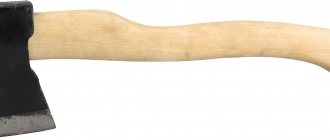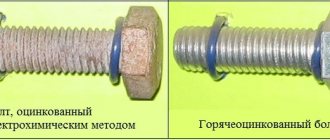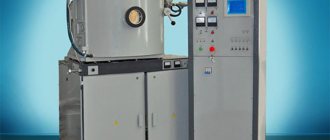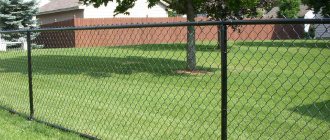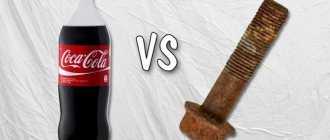To protect metal structures, machines, equipment and parts from corrosion, various materials are used - metallic, non-metallic, paint and varnish. The corrosion resistance of protective coatings depends on many factors: exposure to a specific environment, application technology, size and shape of parts, thickness and properties of the coating. All these parameters must be taken into account during design.
In this article we will take a closer look at all types of protective coatings against corrosion.
TYPES OF METAL COATINGS
When choosing metal coatings, in addition to everything else, you need to take into account its cost, hardness and decorative properties. The cost is affected by the application technology. For example, immersing a part in molten metal requires less cost than electrodeposition. And this, in turn, requires less costs than spraying and cladding.
Based on cost, metal protective coatings against corrosion are divided into 3 groups:
• cheap – zinc, iron, lead;
• medium – nickel, tin, cadmium, aluminum;
• expensive – silver, palladium, gold, rhodium.
The hardness of the coating matters when the surface is subject to wear. The hardest are chrome and nickel. Copper, zinc and silver have lower hardness. And the softest ones are tin, lead, gold and indium.
You also need to consider the color, brightness and appearance of the coating. Copper, zinc, cadmium, nickel, silver and gold give a good shine. And aluminum, lead and tin form dull coatings. However, if you use roll cladding technology, you can get a mirror-like aluminum shine.
For parts that operate at high temperatures, it is preferable to use aluminum, nickel and chromium coating.
Metal coatings are applied to carbon steel.
They are divided into 2 groups: anodic with a negative potential - chromium, zinc, aluminum, manganese, and cathodic with a positive potential - platinum, gold, silver, copper, tin, nickel, cadmium. Anodic coatings are destroyed under the influence of the external environment, while cathodic coatings mechanically block the access of an aggressive environment to the surface of the base metal.
Figure 1 Corrosion destruction when using cathodic (a) and anodic (b) protective coatings.
Before choosing a method of protecting a product, the designer must take into account the properties of metal coatings.
Zinc coatings.
Zinc is applied to the surface of parts by hot melt immersion, electroplating and sputtering, vacuum deposition and zinc-filled paints. The protective properties of such a coating depend on its thickness and the aggressiveness of the environment.
Zinc coatings provide good protection against corrosion if metal parts and structures are used in a clean atmosphere. Their resistance is reduced by impurities of sulfur dioxide and hydrogen sulfide, which are typical for industrial centers and livestock buildings.
Zinc coatings provide excellent protection against the destructive effects of gasoline and tap water. Experts do not recommend choosing this type of corrosion protection if the product will come into contact with sea water, organic and inorganic acids and strong alkalis. The durability of zinc coating can be increased by galvanic deposition with the addition of nickel to the zinc alloy.
Aluminum coatings.
Applied to metal surfaces by hot melt immersion, metallization, plating and vacuum deposition. Aluminum coatings resist corrosion well in polluted industrial atmospheres. On average, destruction occurs after 6 years. This type of coating performed especially well in environments contaminated with sulfur compounds.
Aluminum coatings effectively protect parts when exposed to high temperatures, in clean soft water, soil and acidic environments. This type of coating is not allowed in alkaline environments and sea water.
Aluminum coatings are often subject to crevice damage. It is not recommended for use in contact with copper and its alloys, as well as in atmospheres containing explosive mixtures.
Cadmium coatings.
Applied to parts made of ferrous and non-ferrous metals using the electrolytic method and vapor deposition. Such coatings protect against corrosion when used in sea water or a solution of chloride salts. They are stable in acidic and neutral environments (with the exception of mineral acids). They do not dissolve in alkalis. Parts made of high-strength and spring steels are well protected from corrosion and stress-corrosion cracking. Cadmium coating is applied to bolts, nuts and other threaded parts.
Cadmium is toxic and should not be used on items that come into contact with food or where post-coating welding is required.
Table 1. Corrosion rates of cadmium and zinc coatings
Chrome coatings.
Mainly used for decorative finishing of parts. Chrome-plated parts are highly reflective, resist corrosion well and do not tarnish.
Chromium coatings are produced using the electrolytic method and the diffusion chromium plating method. This type of coating is used for machine parts in rural and industrial areas, in hydrogen sulfide environments, in solutions of certain salts and nitric acid. Not suitable for use in hydrochloric acid.
Nickel coatings.
They protect steel products from corrosion only mechanically if there are no pores in them. This type of corrosion protection is used for parts made of steel, copper and its alloys, for decorative finishing of surfaces, as well as to increase the wear resistance of rubbing surfaces.
Nickel coatings are widely used in mechanical engineering, instrument making, radio engineering and automotive industries, as well as for the restoration of worn machine parts. When using this type of coating, you need to take into account that it will fade over time, as well as the fact that shiny nickel, which contains sulfur, corrodes faster than matte and semi-shiny.
Nickel is resistant to high temperatures and effectively protects the metal from corrosion when in contact with fresh and sea water.
Coatings made of copper and its alloys.
Applied to parts by deposition or chemical reduction from solutions. They reliably protect metal surfaces thanks to a dark oxide surface film.
Copper coatings are very sensitive to ammonia. Even a small amount of it in the environment causes intense corrosion.
An alloy of copper and zinc is used as a decorative coating, as well as to improve the adhesion of rubber to other metals. Copper is primarily used as an intermediate layer for nickel-chrome plating on steel.
Lead coatings.
Lead has high corrosion resistance in the atmosphere, river and sea water, soil and acids. Even in the presence of hydrogen sulfide, sulfur dioxide and carbon dioxide in the atmosphere, lead coatings are not destroyed. But its resistance decreases if there are chlorine ions in the environment.
Tin coatings.
Excellent protection against corrosion in any environment except acidic and strongly alkaline. Tin is widely used to protect products that come into contact with food, as well as to coat home and industrial kitchen equipment and water heaters.
If the atmosphere in which the equipment is operated is contaminated with sulfur oxides, it is more effective to add lead to the tin coating. But provided that the coatings are not subject to high toxicity requirements. For example, these could be fuel storage tanks.
Coatings with noble metals.
Noble metals include gold, silver, palladium, rhodium, osmium, ruthenium and platinum.
Gold is resistant to destruction in all environments except a mixture of hydrochloric and nitric acids. Plus, it doesn't fade. Gold and silver, in addition to their usual use in jewelry, are used in the electrical and electronic industries.
Rhodium protects silver from tarnishing. It is also used for finishing metal reflectors and electrical contacts.
Due to their high cost, precious metals are limited in industrial production.
Table 2. Applications of metal coatings.
| №pp | Coatings | Main material | Application | Application method |
| 1 | Zinc | Steel, aluminum alloys | As protective coatings for parts exposed to the atmosphere, gasoline, water and soil | Hot dip, electrodeposition, metallization, vacuum deposition |
| 2 | Aluminum | Steel | For parts exposed to the atmosphere (including industrial), water, working in contact with soil. For parts subject to high temperature oxidation or hot gases | Hot dipping, metallization or cladding, vacuum deposition |
| 3 | Aluminum | Aluminum alloys | For parts exposed to aggressive environments, immersed in water or soil; for protecting aluminum alloys from stress corrosion | Metallization or plating |
| 4 | Cadmium | Steel, non-ferrous metals | For parts exposed to moisture, sea water, chloride salts, organic vapors; for surfaces requiring good fusibility; for low torque threaded clamps and components in contact with aluminum | Electrodeposition or vapor deposition |
| 5 | Chrome | Steel | As protective coatings for parts exposed to rural and industrial atmospheres, hydrogen sulfide, high temperatures (up to 800 °C); as a wear-resistant coating | Electrodeposition, diffusion coating |
| 6 | Chrome | Aluminum, copper and its alloys, zinc and its alloys | For parts resistant to wear and high temperature oxidation | Diffusion coating |
| 7 | Nickel | Steels or zinc alloys, copper and its alloys, aluminum | As anti-corrosion coatings for machine parts exposed to weathering, high temperatures and in contact with fresh or sea water (often used in conjunction with copper base coats and chrome top coats); for protective coatings in chemical installations; to ensure hardness and wear resistance | Electrodeposition, metallization, cladding, chemical deposition |
| 8 | Nickel | Plastic | As pre-coats | Chemical reduction and electrodeposition |
| 9 | Copper | Steel and its alloys | As an intermediate coating to protect nickel-chromium coatings; for coating printed and electronic products or engraving | Electrodeposition or chemical reduction |
| 10 | Copper | Plastic | As pre-coats to protect coatings on plastics | Chemical reduction and electrodeposition |
| 11 | Copper | Steel | As protective coatings resistant to atmospheric and aquatic environments; for surfaces requiring good fusibility and electrical conductivity | Electroplating, chemical reduction or cladding |
| 12 | Lead | Steel or copper | For coatings resistant to acids in chemical installations; to impart resistance to weathering in aquatic environments or soil; in order to ensure high fusibility; for sound insulation | Hot dip, cladding or electrodeposition |
| 13 | Tin | Steel, copper and its alloys | As coatings protecting against weathering, aquatic environments or organic acids; in the food industry in the manufacture of cans: in order to create good fusibility and electrical conductivity of surfaces | Hot dip or electrodeposition |
| 14 | Gold | Copper and its alloys | As protective coatings with good electrical conductivity in electronics | Electrodeposition, chemical reduction, cladding or vacuum deposition |
| 15 | Gold | Plastic | As electrically conductive coatings | Chemical reduction or vacuum deposition |
| 16 | Silver | Copper and its alloys, nickel and its alloys | As protective coatings for parts of chemical plants and electronics products | As protective coatings for parts of chemical plants and electronics products |
| 17 | Silver | Plastic | As protective coatings, as well as to provide increased electrical conductivity | As protective coatings, as well as to provide increased electrical conductivity |
Advantages
All of them are quite simple to use and apply; the work does not require special training. Using these compositions, you can quickly and efficiently process metal structures of complex design and large dimensions.
The coverage also has a number of bonuses. They are not only inexpensive, but also have the following advantages:
- the coating can be of any color, you just need to choose one or another palette;
- the compositions have high protection characteristics;
- If the coating becomes damaged during operation, they can be easily restored.
Most corrosion control products are primarily used for long-term insulation of metal elements present in the structure. This processing method can be successfully combined with decorative finishing. External aesthetics in the final result are important. Moreover, if the work is carried out carelessly, then there is a possibility that after a while corrosion will reappear and be more dangerous.
TYPES AND PURPOSE OF PAINT COATINGS
When choosing paints and varnishes, it is necessary to take into account not only the operating conditions of a particular product in certain conditions, but also the requirements of technical aesthetics for finishing.
Table 3. Types of protective coatings against corrosion. Paints and varnishes.
Table 4. Groups of paints and varnishes by purpose.
What should you pay attention to?
However, excessive use of existing production volumes will not only lead to overspending and a large increase in the time required to dry the metal structure, but also, too thick a layer of paint often causes cracks in the coating that form during drying.
Much depends on the quality of the paint applied. If before applying the coating to the surface you notice that it is too liquid and spreads quickly, the manufacturer may have added an excessive amount of water. Then you will have to purchase another paint or you should add special substances to your existing paint to prevent excessive spreading of the paint material.
At the same time, if you apply paint very thinly, this can lead to ineffective protection of metal structures, which affects the molecular bonds of the paint coating, and also leads to too rapid destruction - that is, the paint will simply rub off and the original appearance of the coating will be lost.
BASIC PROPERTIES OF PAINT AND VARNISH MATERIALS
Alkyd.
They are divided into 2 types - glyphthalic and pentaphthalic. Durable coatings with good adhesion and decorative appearance.
Glyphthalic ones are mainly used as indoor primers, while pentaphthalic ones are used to protect surfaces that are used in a temperate climate. Alkyd paints and varnishes are applied by brush, rollers, spraying, pouring, etc.
Alkyd styrene.
They form shiny films and adhere well to metal surfaces. Durable and hard coatings. Resistant to periodic exposure to gasoline, soapy water solutions, alkali and mineral oils.
Melamine and urea alkyd.
Well protected against corrosion. Elastic, with excellent decorative properties. They do not adhere to metals as well as alkyds, so they are applied to previously primed surfaces. Urea alkyd coatings are less durable than melamine alkyd coatings.
Phenolic.
Water- and weather-resistant, durable, with good adhesion and mechanical strength. Phenolic enamels effectively resist corrosion and are resistant in tropical climates. Some of them have good resistance to acids, gasoline and oils.
Water-borne.
Obtained on the basis of water-soluble synthesized resins: acrylic, alkyd, epoxy, phenol and melamine-formaldehyde.
Epoxy and epoxy ester.
They form films that remain resistant to water, alkalis, weak acids, mineral oils and various types of fuel. Such coatings have good adhesion and have electrical insulating properties.
The disadvantage of these coatings is their tendency to yellow and chalk when exposed to sunlight.
Polyurethane.
Coatings with high decorative qualities, hard. Excellent resistance to abrasives, fresh and sea water, mineral acids, gasoline, kerosene, atmosphere, pollution by industrial gases and dust and precipitation.
Disadvantage: they are toxic and are destroyed by exposure to light.
Organosilicon.
Form coatings resistant to low and high temperatures. They have good electrical insulating properties in humid environments. The coatings are resistant to mineral oils, gasoline, water, salt solutions, weak acids and alkalis. However, their adhesion to metal is not as strong as that of alkyd and epoxy coatings.
Perchlorovinyl.
They have high weather resistance and good protective properties. Disadvantages - they are sensitive to light, cannot withstand temperatures above 100 0C, and also weakly adhere to unprimed metal surfaces.
Materials based on vinyl chloride copolymers. They have good elasticity and high strength. Disadvantages include low weather and light resistance. Before applying this type of corrosion protective coating, surfaces are primed with acrylic, alkyd and phenolic oil primers.
Polyacrylic and alkyd acrylic.
The coatings are resistant to light and atmosphere. They have mechanical resistance and shine. They are not afraid of water, gasoline and lubricating oils.
Used for painting buses, trolleybuses, agricultural and livestock vehicles. The surfaces are pre-primed with alkyd, phosphating and phenol-oil materials.
Nitrocellulose.
Hard and shiny. Resistant to gasoline and oils. However, these coatings are inelastic, burn well and are destroyed by light and heat. In order to increase adhesion to metal, hard resins are added to nitrocellulose coatings.
Polyvinyl acetal.
Adhere well to iron-carbon and non-ferrous alloys. Withstands high and low temperatures, gasoline, kerosene, mineral oils, hot water and steam.
Oil-free bitumen.
Used to protect products that operate in water or in conditions of high humidity, as well as when stored in warehouses. Often aluminum powder is introduced into such a coating. This gives the product a silvery color and increases resistance to atmospheric degradation.
Oil-varnish.
They give a hard, shiny coating that can be easily sanded. However, this type is not weather resistant. They are used for finishing products that work indoors.
Primers.
Increases the strength, durability and protective properties of the product. Primers for metal surfaces are divided into 4 groups: inhibitory, passivating, phosphating and protective.
The composition of inhibitor primers includes lead and iron lead, lead crown, zinc white, mummy, and soot. They slow down the corrosion process.
Passivating primers contain zinc and strontium crowns, potassium chromate and other chromic acid salts. These pigments form a film on the surface of the metal, which increases its corrosion resistance.
Phosphating primers contain orthophosphoric acid, which serves as protection against atmospheric corrosion.
Protective primers contain zinc, aluminum and magnesium powders. These pigments will be destroyed under the influence of an aggressive environment and protect the surfaces of steel parts.
The quality of the coating depends on the application method.
It can be dipping, jet painting, slow dipping, watering method, roller method, electrodeposition method, pneumatic spray, airless, electrostatic spray, brush method.
Depending on the situation and the desired result, the designer, when developing parts, can either make changes to the structure of the parts, or introduce into the documentation specific restrictions on the use of a particular method of applying paint and varnish material.
Safety at work
In order to most effectively eliminate the likelihood of poisoning and illnesses arising from work related to the application of paint and varnish coatings, you will be required to strictly follow safety regulations.
First of all, in the rooms where work will take place, it is necessary to ensure good ventilation. Then, if this is a large room, then the people performing paint and varnish work must be provided with all the necessary personal protective equipment - that is, mittens and overalls.
Moreover, special attention from this list should be paid specifically to respiratory protection equipment - that is, masks and half masks - respirators. Also, you or your workers should remember about personal hygiene. To clean your hands from paint and varnish materials, you can use special cleaning pastes. But under no circumstances use solvents to clean the skin, as this leads to the appearance of a rash on the skin, as well as various allergic irritations.
In order to promptly identify various diseases of this nature, it is necessary that people who do paint and varnish work undergo periodic medical examinations in order to prevent the occurrence of these dermatological diseases.
SELECTION OF NON-METALLIC MATERIALS AND COATINGS
This type of protective coating against corrosion includes polymer materials, rubber coatings, conversion, ceramic and enamel coatings.
Polymer substances and plastics have low density, high mechanical and waterproofing properties and chemical heat resistance, adhere well to metal and have a high degree of sound insulation and sealing.
These coatings are produced on the basis of thermoplastic and thermosetting polymers.
Thermoplastics do not lose their properties when heated, which is different from thermosetting ones.
Polymers protect metal surfaces exposed to aggressive air environments.
Table 6. Assessment of the aggressiveness of air exposure.
Corrosion characteristics
Therefore, it is necessary to immediately discuss what corrosion is? This process is a specific chemical reaction. It occurs only when favorable conditions appear for this process.
Corrosion can appear on various metal surfaces if:
- the material will interact with water over a certain period of time,
- when the metal surface is in an open area,
- If all operating conditions have not been met, the metal itself is deformed, and its properties change so much that it becomes unsuitable for further use.
The metal, undermined by the external environment, crumbles and changes color and texture.
BASIC POLYMER MATERIALS
Polyethylene.
The most common polymer. It is highly resistant to water and aggressive environments at temperatures up to 600 C, as well as to acids, alkalis, oxidizing agents and solvents. Sulfuric and nitric acids destroy polyethylene at temperatures above 600 C. It is practically unaffected by oils, fats, kerosene and other petroleum hydrocarbons.
Disadvantages of polyethylene - it is easily flammable, ages from the sun, deforms under prolonged loads, and cracks may appear on it.
Table 7. Service life of polyethylene in various environments.
Polyisobutylene.
Resistant to most acids and alkalis, salt solutions and water. Insoluble in alcohols, ethers and ketones. Easily dissolves in aromatic and chlorinated hydrocarbons. Damaged by oils, fats and sunlight in the presence of oxygen and air.
Most polyisobutylene is used in the chemical industry to protect equipment from corrosion.
Polypropylene.
It is characterized by a high melting point (up to 1700 C), resistance to aging, the action of water, non-oxidizing acids, alkalis and salt solutions. However, nitric acid destroys polypropylene at high temperatures.
Polyvinyl chloride.
Durable material. Based on it, 2 types of plastics are produced - hard (vinyl plastic) and soft (plastic).
Viniplast tolerates acids, alkalis, alcohols, oils, gasoline well; well formed and welded.
The plastic compound is resistant to water, alkalis and acids of low and medium concentrations and becomes brittle from mineral oils and organic solvents.
Plastic does not adhere well to metal surfaces, so products are pre-primed with adhesives based on phenolic and epoxy resins and thermoplastic adhesives based on a copolymer of vinyl chloride and vinyl acetate.
Fluoroplastics.
They are chemical and weather resistant and are not afraid of either high or low temperatures. They are divided into polytetrafluoroethylene, polytrifluoroethylene, polyvinyl fluoride and polyvinylene fluoride.
Polytrifluoroethylene is superior in chemical resistance to other synthetic polymers, noble metals, special alloys and ceramics. Used to protect parts that operate in highly aggressive environments. For example, steel pipes through which a hot (temperature close to the boiling point) mixture of hydrofluoric and nitric acids flows can withstand operation for 2 years.
Polytrifluoroethylene is used in the form of powders and suspensions to protect containers in which battery sulfuric acid is stored.
Polyvinyl fluoride is used in the form of a film in the chemical industry to protect the internal and external walls of buildings and structures.
Polyvinylene fluoride is used for lining pipelines, valves, pumps and containers that operate in highly aggressive environments.
Pentaplast.
Resistant to alkalis, some acids and organic solvents. It is well processed by injection molding and has excellent weldability.
Gumming protective coatings.
Resistant to the action of most inorganic compounds, except for strong oxidizing agents: nitric, chromic and concentrated sulfuric acids. Rubber coatings are divided into sheet material and liquid rubber.
Table 9. Resistance of rubber coatings in aggressive environments.
Conversion coatings.
These are coatings of salts and oxides that are sparingly soluble in water, which are obtained as a result of the interaction of the base metal with solutions.
Phosphate, chromate and anodized coatings from this group are widely used.
Ceramic coatings.
Coatings of high-melting metals, oxides and carbides obtained using plasma spraying. The most common are aluminum oxide, zirconium dioxide and tungsten carbide.
They are used to increase the heat resistance and wear resistance of carbon steel parts. The disadvantages of ceramic coatings include: porosity, poor adhesion to the base, changes in the internal structure with changes in temperature.
Enamel coatings.
Applied to steel and cast iron products. They can sometimes be used to protect copper, brass and aluminum surfaces. Coatings are resistant to organic and inorganic acids, except hydrofluoric and hot concentrated phosphoric acid.
Enamel coatings can be used at temperatures up to 600 0C, and special types of enamels can withstand temperatures up to 1000 0C for a short time. The disadvantage of enamels is that they are brittle and crack with sudden changes in temperature. Used to protect equipment in the chemical, pharmaceutical and food industries, in the manufacture of tableware and sanitary equipment.
All coatings that are described in this article, in combination with metal processing with shot blasting equipment, create reliable protection of metal surfaces from corrosion and extend the wear resistance and service life of equipment, parts and structures.

